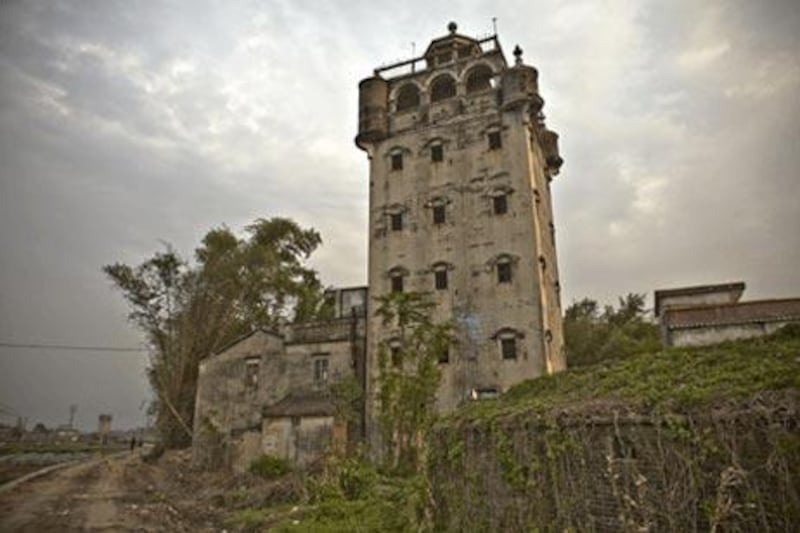The sight of Romanesque architecture in rural China is a surprise that masks a greater problem for the emerging economic powerhouse. The country learnt of other cultures' designs through the loss of its people to emigration. Foreign correspondent Clifford Coonan reports The classic image of farmers tending their rice and tobacco fields in southern China is disturbed by the fortified castle in Italian Renaissance style.
The jarring sight of medieval turrets and arches bears testament to Taishan's history as an emigration centre for hundreds of years, as Chinese left for Britain, the US and Canada setting up restaurants, building railways and panning for gold in the expanding New World. These days, the people of Taishan are leaving in droves to study in the universities and work in software companies in the West, and the government is worried about a brain drain that could stifle innovation as China emerges as an economic powerhouse.
The slits in the walls of the towers, through which the residents would shoot at marauding bandits, are relics from an earlier period of mass migration. Approaching the buildings you see a narrow, heavily fortified entrance. The windows are small and barred, but very ornate - clearly a difficult proposition for an early 20th century bandit keen to steal the booty of a returned emigrant flush with cash from building the railways of the American West. At the top are turrets and Romanesque arches.
Some of the buildings are more than 400 years old, but most were built by these returned emigrants in the early 20th century to protect their money from robbers in the period of lawlessness that characterised the dying days of the Qing dynasty, which ended in 1911, and the early Republican period of Chinese history. "During the late Qing dynasty, there were lots of bandits in Taishan and they attacked villagers and launched raids," says Cai Hetian, a director of the Taishan museum. "So the villagers built these structures with defensive elements on each of the four corners.
"The buildings were also used by local people to flee to during times of flood. Later, some immigrants came from overseas and brought with them these baroque styles, and Gothic and Italian styles. "Those immigrants who came back built these houses for two reasons - to live in and to defend themselves against bandits." Driving out of Zhuhai, bordering Macau, you see these houses dotting the countryside. Many of them have Chinese characters on the top, which name the family and have good luck messages such as "Ming Prosper Building" or "Lou Success Peace".
In China, a combination of the rush to modernity and poor construction has seen many significant buildings destroyed, but the area around Taishan is full of wonderful examples of Chinese takes on the great architectural styles of the West. There are whole streets with covered arcades similar to the style seen in northern Italian cities such as Bologna, and family homes modelled on the Romanesque Palazzo Vecchio in Florence. Others are built in Spanish adobe style, and there are also dwellings with strong elements of South East Asian architecture.
But many of the owners of these buildings have left the country. Some chose to stay away after the revolution in 1949; others were landowners who were persecuted by the communists in various "anti-rightist" campaigns in the 1950s. The Wu family built a redbrick house, complete with an altar for ancestor worship, but they have since all emigrated to Canada and Britain and the house has been converted into a school.
Many buildings were constructed with materials that were destined to crumble, especially the earlier cannon towers that were built using mud and earth, and have nearly all fallen away. The later constructions used what the locals called "red cement", referring to the fact that many of the British engineers who came to the area in the early 20th century were believed to have red hair. Since that turbulent period, about 3,000 towers have crumbled or been destroyed in Taishan, leaving fewer than 2,000 standing today.
Mr Cai is on a campaign to have the overseas Chinese hand over the buildings to the government, so they can be renovated and preserved for posterity, and developed as tourist attractions. Some of the watchtowers have been given World Cultural Heritage status by UNESCO, such as those in Kaiping. But many of the buildings are in a dangerous state of repair. "So many of these buildings are falling down," says Mr Cai. "It's a big headache for us, trying to preserve them. So we are trying to get in touch with the owners overseas to see if they will hand them over to the government to take care of. That way we can develop tourism."
The area around Taishan is one of the great emigration centres of China, and the museum has an exhibition about the hundreds of thousands who left the area over the years. The Taishanese settled in Hong Kong, San Francisco and Canada. Gary Locke, the US commerce secretary and former governor of the state of Washington, is descended from Taishanese. Taishanese also have a link with aviation. There is a decommissioned MiG fighter outside the museum, and one quarter of the "Flying Tigers", the legendary group of American volunteer airmen who fought the Japanese during the Second World War before the US entered it, came from Taishan.
The flow of people has not slowed much, and local leaders are worried about a brain drain as the population has dropped by nearly 10 per cent in the past two decades, to less than a million people. In a 2007 report, the Chinese Academy of Social Sciences reckoned that more than 300,000 talented Chinese emigrants are working in high value-added industries in other countries. Tens of thousands of university graduates leave China every year and more than a million Chinese students have studied abroad since the 1980s, when China started to open up and reform. Two thirds of them stay abroad after graduating.
"There is a lot of depopulation here as many travel overseas," Mr Cai says. "The population continues to grow but many leave. Many find it easy to migrate because they have relatives overseas, or a boyfriend or girlfriend overseas. And many go to study." Last year China overtook the UK and New Zealand as the biggest originator of immigrants in Australia. The situation is becoming so bad that the Beijing government has launched the "Thousand Person Plan", aimed at wooing young Chinese with doctorates back from foreign universities with tax exemptions.
But it is not all one-way. A UN report estimates that China receives about US$20 billion (Dh73.46bn) a year from emigrants, and is one of the largest beneficiaries globally of remittances. But not enough of this cash is finding its way to the crumbling, beautiful castles of Taishan. The brain drain threatens to destroy one of the great architectural oddities of the world. @Email:business@thenational.ae





